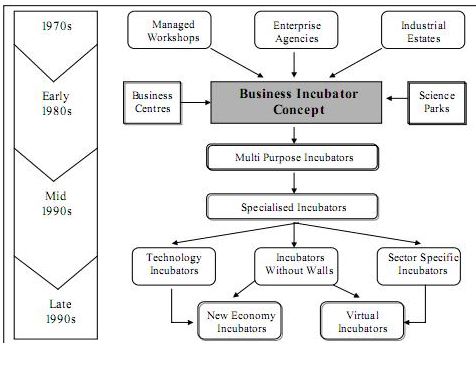Business incubation was a concept that started in the United States in 1959 when the Batavia Industrial Centre was opened. Incubation expanded in the US and spread to the UK, then Europe.
The following graphic shows a “potted history” of business incubation.
 In Australia, business incubation was supported by governments in the 1990’s but since then, the term has been
somewhat debased by “fashion” and carpet-bagger consultants trying to ride a
catchy phrase transformed it to become an offering of its parts rather than as
a total concept.
Hence many consultants now offer “Business Incubation services” to Indigenous organisations, to the extent that in
Indigenous organisations today the term “Business Incubation” means to offer
community members some form of support to help them start business, whether
this be micro-financing, business planning services, or book-keeping services.
While these individual services can help Indigenous small business owners, taken as individual services they cannot
holistically help develop a start up business invariably conceived by someone
in the community who is starting up from ground zero. Business services provided
singly do not provide the support and tailored tutoring and mentorship to
ensure the business aspirants are taken on the whole journey of business
start-up and establishment. What is an aspirant going to...
In Australia, business incubation was supported by governments in the 1990’s but since then, the term has been
somewhat debased by “fashion” and carpet-bagger consultants trying to ride a
catchy phrase transformed it to become an offering of its parts rather than as
a total concept.
Hence many consultants now offer “Business Incubation services” to Indigenous organisations, to the extent that in
Indigenous organisations today the term “Business Incubation” means to offer
community members some form of support to help them start business, whether
this be micro-financing, business planning services, or book-keeping services.
While these individual services can help Indigenous small business owners, taken as individual services they cannot
holistically help develop a start up business invariably conceived by someone
in the community who is starting up from ground zero. Business services provided
singly do not provide the support and tailored tutoring and mentorship to
ensure the business aspirants are taken on the whole journey of business
start-up and establishment. What is an aspirant going to...
Read more
 In Australia, business incubation was supported by governments in the 1990’s but since then, the term has been
somewhat debased by “fashion” and carpet-bagger consultants trying to ride a
catchy phrase transformed it to become an offering of its parts rather than as
a total concept.
Hence many consultants now offer “Business Incubation services” to Indigenous organisations, to the extent that in
Indigenous organisations today the term “Business Incubation” means to offer
community members some form of support to help them start business, whether
this be micro-financing, business planning services, or book-keeping services.
While these individual services can help Indigenous small business owners, taken as individual services they cannot
holistically help develop a start up business invariably conceived by someone
in the community who is starting up from ground zero. Business services provided
singly do not provide the support and tailored tutoring and mentorship to
ensure the business aspirants are taken on the whole journey of business
start-up and establishment. What is an aspirant going to...
In Australia, business incubation was supported by governments in the 1990’s but since then, the term has been
somewhat debased by “fashion” and carpet-bagger consultants trying to ride a
catchy phrase transformed it to become an offering of its parts rather than as
a total concept.
Hence many consultants now offer “Business Incubation services” to Indigenous organisations, to the extent that in
Indigenous organisations today the term “Business Incubation” means to offer
community members some form of support to help them start business, whether
this be micro-financing, business planning services, or book-keeping services.
While these individual services can help Indigenous small business owners, taken as individual services they cannot
holistically help develop a start up business invariably conceived by someone
in the community who is starting up from ground zero. Business services provided
singly do not provide the support and tailored tutoring and mentorship to
ensure the business aspirants are taken on the whole journey of business
start-up and establishment. What is an aspirant going to...

 He believes that can only be achieved if the organisation and its leadership demonstrate some fundamental behaviour that point to resilience.
Resilience is not only important in the hard times or during change. It must also be demonstrated when business is going well. That can be a challenge for many leaders, who Oh says are generally suited to only one style of an economy.
Many perform well when the economy is also doing well. Other leaders rise to the challenge when the economy does badly; Oh points out that it is relatively easy to think of great leaders who have turned companies around. However, they may not have been so successful when the business was back on track.
Oh says resilience needs to be a constant, rather...
He believes that can only be achieved if the organisation and its leadership demonstrate some fundamental behaviour that point to resilience.
Resilience is not only important in the hard times or during change. It must also be demonstrated when business is going well. That can be a challenge for many leaders, who Oh says are generally suited to only one style of an economy.
Many perform well when the economy is also doing well. Other leaders rise to the challenge when the economy does badly; Oh points out that it is relatively easy to think of great leaders who have turned companies around. However, they may not have been so successful when the business was back on track.
Oh says resilience needs to be a constant, rather...
 Australian Indigenous enterprises can be categorised into three main categories:-
Australian Indigenous enterprises can be categorised into three main categories:-

